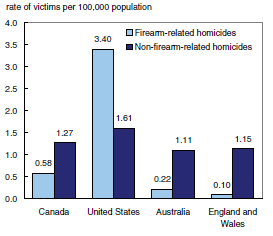Just thought I would through some numbers up for you guys to make you happy. I know you're going to find multiple ways to blow holes in this data as I would yours...
This will be my last post. Perhaps I've had too much time on my hands over the holidays and started psoting. I'm bowing out and switching back to the read only version. You've won... Hope you're happy. This has been like talking to a brick wall and not worth my time. I've been a member since 2008 and have really appreciated the many things I've learned on this forum. Unfortunately, I believe if the general public read this forum, it would be a great embarrassment to the Alberta outdoorsman...
Let the bashing begin once again...
Canada's firearm homicide rate is lower than the United States but higher than Australia and England and Wales...
This compares Canada's firearm-related homicide rates to those in the United States, Australia, and England and Wales. The crime of homicide is selected for two reasons. First, unlike other crimes, the definition of homicide tends to be fairly consistent across nations, thus enabling international comparisons. Second, because of its severity, homicide is more likely than any other crime to be known to police and to be the subject of thorough investigation. Thus, a census of detailed homicide data, including the type of weapon used to commit the offence, is available from each of the four countries. Whether the rates of other firearm-related violent crimes, such as attempted murder or robbery, would show the same pattern as homicide is unknown.
Overall homicide rates are highest in the United States, followed by Canada, Australia, and England and Wales. While non-firearm homicide rates are similar between the four countries, the rates of firearm-related homicides are quite different (Chart 4). In 2006, Canada's firearm-related homicide rate (0.58) was nearly six times lower than the United States (3.40), but about three times higher than the rate in Australia (0.22) and six times higher than the rate in England and Wales (0.10). Firearms accounted for about one-third (31%) of all homicides in Canada, approximately two-thirds (68%) in the U.S., 16% in Australia and 7% in England and Wales.
Homicide by method for selected countries, 2006

Source: Statistics Canada, Canadian Centre for Justice Statistics, Homicide Survey; Federal Bureau of Investigation (FBI), Department of Justice, Washington, D.C.; Australian Institute of Criminology; and England & Wales Home Office.
All four countries reported that handguns were the most common type of gun used in the commission of firearm-related homicides. In 2006, handguns were responsible for 75% of all firearm-related homicides in the United States, 57% in Canada, 47% in Australia and 44% in England and Wales.
Canadian homicide data from 2003 to 2006 indicate that where registration status was known, 7 in 10 firearms used to commit homicide were reported by police to be unregistered.2 Among persons accused of homicide, 27% were found to possess a valid firearms license. Data from Australia show that most firearms used to commit homicide are unlawfully held by accused persons (Mouzos, 2000).